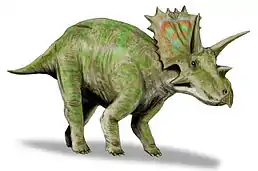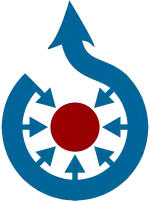Anchiceratops
Anchiceratops („Blízkorohá tvář“) byl rod středně velkého ceratopsidního dinosaura žijícího v období svrchní křídy (asi před 73 až 71 miliony let) na území Severní Ameriky (Alberta v Kanadě). Fosilie tohoto ceratopsida byly objeveny v sedimentech souvrství Horseshoe Canyon a souvrství Oldman.
Stratigrafický výskyt: Svrchní křída, před 72,5 až 71 miliony let | |
|---|---|
 Rekonstrukce vzezření anchiceratopse | |
| Vědecká klasifikace | |
| Říše | živočichové (Animalia) |
| Kmen | strunatci (Chordata) |
| Třída | plazi (Reptilia) |
| Nadřád | dinosauři (Dinosauria) |
| Řád | ptakopánví (Ornithischia) |
| Podřád | Cerapoda |
| Infrařád | ceratopsové (Ceratopsia) |
| Nadčeleď | Ceratopsoidea |
| Čeleď | Ceratopsidae |
| Podčeleď | Ceratopsinae |
| Rod | Anchiceratops Brown, 1914 |
| Druhy | |
| |
| Některá data mohou pocházet z datové položky. | |
Popis
Stejně jako ostatní rohatí dinosauři byl i Anchiceratops čtyřnohý býložravec se třemi rohy na hlavě, jakoby papouščím zobákem a dlouhým límcem za hlavou. Tento dinosaurus mohl dosahovat délky kolem 4,5 až 6 metrů[1] a hmotnosti asi 1500 kg.[2]
Historie a význam

Anchiceratops byl popsán v roce 1914 paleontologem Barnumem Brownem. Dnes známe jen jeden validní druh, A. ornatus. Některé nálezy relativně menších jedinců se zdají nasvědčovat sexuálnímu dimorfizmu (rozdílné velikosti obou pohlaví) u tohoto dinosaura.
Anchiceratops mohl být přímým vývojovým potomkem rodů Pentaceratops, Navajoceratops a Terminocavus.[3]
Reference
- Holtz, Thomas R., Jr.; Rey, Luis V. (2007). Dinosaurs: The Most Complete, Up-to-Date Encyclopedia for Dinosaur Lovers of All Ages (Aktualizovaný internetový dodatek, str. 51). New York: Random House. ISBN 978-0-375-82419-7.
- Paul, G. S. (2016). The Princeton Field Guide to Dinosaurs (2nd Edition). Princeton University Press, str. 299-300 (anglicky)
- http://dickinsonmuseumcenter.com/badlands_research-2020newceratopsids/
Literatura
- Brown, B. (1914). Anchiceratops, a new genus of horned dinosaurs from the Edmonton Cretaceous of Alberta. With a discussion of the origin of the ceratopsian crest and the brain casts of Anchiceratops and Trachodon. Bulletin of the American Museum of Natural History. 33: 539-548.
- Dodson, P. (1996). The Horned Dinosaurs. Princeton: Princeton University Press. 346pp.
- Farke, A. A. (2004). Ceratopsid dinosaurs from the Upper Cretaceous Almond Formation of southwestern Wyoming. Rocky Mountain Geology. 39: 1-5.
- Langston, W. J. (1959). Anchiceratops from the Oldman Formation of Alberta. National Museum of Canada Natural History Papers. 3: 1-11.
- Lehman, T. M. (1990). The ceratopsian subfamily Chasmosaurinae: sexual dimorphism and systematics. In: Carpenter, K. & Currie, P.J. (Eds.). Dinosaur Systematics: Approaches and Perspectives. Cambridge: Cambridge University Press. Pp. 211-219.
- Sternberg, C. M. (1929). A new species of horned dinosaur from the Upper Cretaceous of Alberta.National Museum of Canada Bulletin. 54: 34-37.
Externí odkazy
 Obrázky, zvuky či videa k tématu Anchiceratops na Wikimedia Commons
Obrázky, zvuky či videa k tématu Anchiceratops na Wikimedia Commons